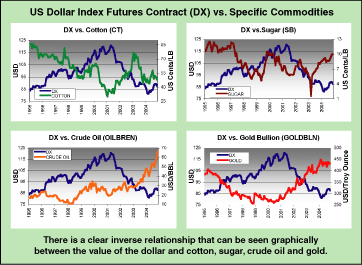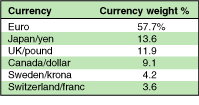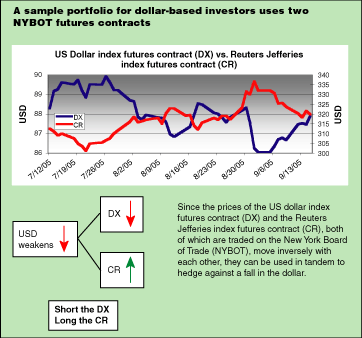
HOT TOPICS LIST
- Strategies
- Stocks
- Buy
- Investing
- Brokers
- Psychology
- Interviews
- Accumulate
- Sell
- Hold
- Spotlight
- Websites
- Candlestick Corner
- Gold & Metals
- Options Trading
LIST OF TOPICS
TRADER'S NOTEBOOK
Customized Portfolio Diversification
11/30/05 11:28:38 AM PSTby Robert L. Lewis & Rena Gelb
And here, some strategies to diversify and protect your portfolio.
| In my last article, "Real Alternative Asset Classes," I talked about classic diversification. Now, let's take diversification a step further and look at customized diversification.
A REAL PORTFOLIO
Figure 1: US DOLLAR INDEX FUTURES CONTRACT (DX) VS. SPECIFIC COMMODITIES. Note the clear inverse relationship between the value of the dollar and cotton, sugar, crude oil, and gold.
The tables in the following figures are examples of what could constitute real alternative portfolios. As you can see in Figure 2, the value of these commodities using real prices as of July 19, 2004, is as shown.
Figure 2: AN EXAMPLE OF A REAL ALTERNATIVE PORTFOLIO
Assuming an investor had a municipal bond portfolio of $1,000,000 generating $50,000 annually (5% return), he might consider investing 10% of his income as shown in Figure 3.
Figure 3: DIVERSIFYING INTO COMMODITIES. You could invest 10% of your income in the contracts listed here.
With this real alternative investment, his bond portfolio would be protected from:
1: A decline in the dollar and
The investor would also have a broadly diversified alternative portfolio covering most segments of the economy. Note that the alternative portfolio contains no interest rate or equity components. The contracts chosen reflect the criteria that determine the future value of the bonds in the primary portfolio. If the dollar takes a tumble and commodity prices rise, the value of the bonds will probably have declined. Just to solidify our understanding, let's consider an investor with a large-cap portfolio of $1,000,000 generating $20,000 annually (2% return). He might consider investing 10% of his income (see Figure 4).
Figure 4: PROTECTING YOUR CAPITAL. Allocating 10% of your portfolio among these commodities will act as a hedge from a rise in dollar values, and a disinflationary economy.
With this investment, his equity portfolio would be protected from:
1: An increase in the dollar, which would make the United States less competitive in world markets, and
Neither portfolio need be limited by the futures selected or by the number of contracts. Everything can be adjusted. An investor may decide to buy puts and calls closer to being in-the-money so that he might improve his chances of the options expiring in-the-money. An investor may also argue the converse and buy options for less money that are further out-of-the-money. It is all a question of temperament and preference. Finally, if you add up the dollar value of contracts controlled by the options, you'll find that it amounts to approximately $472,812.20, based on an investment of $5,087 (see Figure 5).
Figure 5: TWO EXAMPLES OF A REAL ALTERNATIVE PORTFOLIO. Here are two examples of how you can hedge yourself from changes in the US dollar. For example, the predecessor brokerage firms of what is now Smith Barney, a division of Citigroup, had very large retail commodity departments. Even today, Smith Barney's world-class research department publishes broad, insightful weekly and daily commentary on the fundamental and technical analysis of commodities. Smith Barney is a large retail wire house and maintains an impressive and extensive website. If you look on this website you can find a multitude of research that is overwhelming. However, to find any information on futures, you must search long and hard. If you hit "Products," you can then find "Other investments" and then "Futures." Obviously, futures don't receive the same attention as stocks, bonds, or mutual funds.
DOES IT EVER PAY OFF? Nassim N. Talib in his excellent book, Fooled By Randomness, makes the powerful argument that the wings of probability bell curves are wider than we might expect. According to Talib, much of what we think of as "structural" in life is really movements within a random pattern. Talib was formerly head of derivatives for Union Bank of Switzerland and now runs his own hedge fund. As a fund manager, he keeps the bulk of the fund in liquid assets, with the rest invested in deep out-of- the-money options. I must stress that the purchase of out-of-the-money options in conjunction with a managed portfolio is not discussed here as an alternative source of speculative income, but rather as a means of acquiring cheap insurance in the event of dramatic change. The options purchased should behave in the opposite manner of the basic portfolio and should not be purchased for speculative gain through trend watching, market timing, or chart pattern recognition. Even the most conservative farmer hedging his grain crop engages in some speculation, and I suspect the same will happen with investors who purchase these options. It is important to bear in mind that their primary purpose is to ensure the main (and substantially larger) investment portfolio and not to be managed as independent speculative vehicles. In any event, the table in Figure 6 shows examples of recent dramatic price changes that have occurred during the life of the contract.
Figure 6: DRAMATIC PRICE CHANGES CAN HAPPEN Note I did not pick maximum changes, but rather substantial average changes. I attempted to keep the dates as close to the first of the month as possible. I also chose time frames, which could normally occur within the life of a contract.
A VERY SIMPLE APPROACH
US Dollar Index
Figure 7: A SIMPLE HEDGING STRATEGY. The US Dollar Index contract (DX) and the Reuters Jeffries CRB Index contract (CR) can be used to hedge against a fall in the US dollar.
Reuters Jefferies CRB Index
Figure 8: US DOLLAR INDEX. Here you see a weighting of the currencies that make up the US Dollar Index.
The contract size is 200 times the index. It is currently trading at approximately 88, which means that each contract is worth $62,400. If you buy a contract, you are basically buying $62,400 of commodity products. As the prices of these two contracts move inversely with each other, they can be used in tandem to hedge against a fall in the dollar. A concerned investor might seek to protect his portfolio by being short the dollar index and long the CRB index. He would be able to purchase protection against a declining dollar and against rising commodity prices. (See Figure 9.)
Figure 9: REUTERS JEFFRIES CRB INDEX. This index is made up of the commodities you see listed here. As you can see, crude oil has the largest weighting.
With futures, you need only make a small deposit, but you may be liable for margin calls should the contract prices move against you. With each of these contracts, the deposit required is normally less than $2,000 per contract. A person buying or selling these contracts must either:
1: Set aside sufficient reserves for possible margin calls or
Remember the DX at 88 is worth $88,000, while the CR at 312 is worth $62,400. If you are depositing less than $2,000 as margin for each contract, you can almost be assured of margin calls. That said, an investor with a portfolio of $1,000,000 in securities might consider shorting the dollar index and being long the CRB index. In the event that the dollar declines in value, thereby decreasing the value of his dollar-based portfolio, the investor would have some protection by being short a dollar contract. Likewise, should commodity prices soar with unexpected inflation, the CRB contract would increase and thereby offer partial portfolio protection from the ravages of inflation. It is important to note that the investor selling a dollar contract and purchasing a CRB contract hopes to lose money on his futures contracts. A substantial decline in the dollar or an unexpected increase in commodity prices would, in all probability, cause more damage to his portfolio than he could hope to make off his futures contracts. If the investor lost money on these contracts, he would probably be more than compensated with the increase in his portfolio value.
CONCLUSION
Robert L. Lewis is a practicing attorney in New York City and a member of several commodity and stock exchanges. Rena Gelb is a freelance financial consultant and a graduate of Columbia University Business School. SUGGESTED READING Current and past articles from Working Money, The Investors' Magazine, can be found at Working-Money.com.
|
PRINT THIS ARTICLE

|

Request Information From Our Sponsors
- StockCharts.com, Inc.
- Candle Patterns
- Candlestick Charting Explained
- Intermarket Technical Analysis
- John Murphy on Chart Analysis
- John Murphy's Chart Pattern Recognition
- John Murphy's Market Message
- MurphyExplainsMarketAnalysis-Intermarket Analysis
- MurphyExplainsMarketAnalysis-Visual Analysis
- StockCharts.com
- Technical Analysis of the Financial Markets
- The Visual Investor
- VectorVest, Inc.
- Executive Premier Workshop
- One-Day Options Course
- OptionsPro
- Retirement Income Workshop
- Sure-Fire Trading Systems (VectorVest, Inc.)
- Trading as a Business Workshop
- VectorVest 7 EOD
- VectorVest 7 RealTime/IntraDay
- VectorVest AutoTester
- VectorVest Educational Services
- VectorVest OnLine
- VectorVest Options Analyzer
- VectorVest ProGraphics v6.0
- VectorVest ProTrader 7
- VectorVest RealTime Derby Tool
- VectorVest Simulator
- VectorVest Variator
- VectorVest Watchdog









